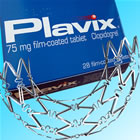|
$442 Million Fine Against
Apotex for Plavix® Patent Infringement
Stent Patients Will Have to Wait for a Generic Version
|
 |

Plavix and
stents: the two
go together |
|
October 23, 2010 --
Apotex Inc., the largest Canadian-owned pharmaceutical manufacturer,
has been hit with a $442 million fine by Judge Sidney H. Stein
of the U.S. District Court, Southern District of New York (Manhattan)
for
patent infringement against Sanofi-Aventis (NYSE: SNY) and its
partner Bristol-Myers (NYSE: BMY), regarding its marketing of
a generic version of
Plavix (clopidogrel), a drug widely used during and after angioplasty
and stent placement. The fine results from a 2007
court decision, upholding Sanofi-Aventis' patent.
The fine is significant for privately-held
Apotex: almost half of its annual global sales for all products,
reported to be around one billion Canadian dollars. |
The generic version of Plavix was
launched by Apotex on August 8, 2006, considered at
the time a bold and "at-risk" move, due to the patient dispute.
Apotex immediately flooded the market with its generic clopidogrel,
resulting in sales of $884 million. 24 days later, Judge Stein
granted Sanofi/Bristol-Myers'
request
for
an injunction,
and this week's penalty represents half of Apotex sales during this
short period.
Plavix and Stents
Plavix is an antiplatelet drug
which prevents blood from clotting. In at risk individuals, a blood
clot (also called thrombosis) can cause
a heart
attack or other coronary problems. It
is routinely given to
patients, along with aspirin,
after
stent
implantation
for 1-2
months following a bare metal stent (BMS) and for 12 months or more
when a drug-eluting stent (DES). The drugs help prevent platelets
from congregating along the exposed metal struts
of the
stent and
forming clots. However, because of
concerns about late
and very
late
stent
thrombosis
(clots
occurring
later than 6 months and up to two or three years) there has been
much controversy over how long Plavix
should
be given to DES recipients, with many cardiologists prescribing the
drug for life.
Duration of Dual Anti-Platelet Therapy
(DAPT)
Although the
question of how long drug-eluting stent patients need to stay on
Plavix and aspirin was first raised
in a
two-day
FDA
stent safety
panel in 2006,
it took three years for a large scale
clinical
trial (over 20,000 patients at 254 locations) to begin enrollment. The
DAPT Study,
being conducted by the Harvard Clinical Research Institute, will cost
many
millions
of
dollars
and
is being
supported by the four major stent companies (Abbott, Medtronic, Cordis
and Boston Scientific) along with the companies that make and market
Plavix (Bristol-Myers Squibb and
Sanofi-Synthelabo) and those that make and market the newest antiplatelet
drug Effient (Eli Lilly and
Daiichi Sankyo Inc.). Results of DAPT won't be known for at least four more years
(final data collection is scheduled for December 2013). Interestingly,
this trial began only months after the FDA
approved Effient (prasugrel)
-- a potential competitor to Plavix.
DAPT will compare outcomes
of stent patients who take 12 months of Plavix or
Effient (plus aspirin) with those who stay on the drugs for 30 months.
The question of whether
or not there's any difference in six months of DAPT (the original
FDA recommendation for drug-eluting stents) will not be addressed,
although other
smaller trials with Medtronic's Endeavor stent, which
is said to heal more quickly, are exploring that question.
Plavix: The Third Largest-Selling U.S.
Drug
Plavix ranks third in U.S. sales of prescription medicine, topping
$4.2 billion for 2009 (up 11% from 2008). At $5.29 for
a 75mg tablet (the latest online pharmacy price from drugstore.com)
this correlates to slightly over two million patients taking one
a day
annually.
Most estimates of angioplasties performed annually in the U.S. range
from 700,000 to one million -- meaning that a very significant portion
of Plavix sales are to stent recipients. Another interesting fact
is that receipt of a stent is NOT technically an "on-label" indication
for Plavix (see "FDA
Policy on Plavix and Stents: Catch-22").
Furthermore, many patients who receive stents may
not be aware of the clinical need for long-term medications, and
may not realize the financial implications. Although most medical
insurance policies cover the stent placement itself, many do
not reimburse for the $2,000 annual Plavix prescription. A sampling
of
problems
patients are facing can be read on Angioplasty.Org's Forum Topic,
"Financial
Assistance for Plavix". Many interventional cardiologists
have taken to assessing whether or not their patients will be able
to afford Plavix for a year or more and, if not, they implant the
older bare metal stent.
Reported by Burt Cohen, October 23, 2010
|

